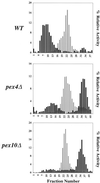The peroxisome biogenesis factors pex4p, pex22p, pex1p, and pex6p act in the terminal steps of peroxisomal matrix protein import
- PMID: 11003648
- PMCID: PMC86304
- DOI: 10.1128/MCB.20.20.7516-7526.2000
The peroxisome biogenesis factors pex4p, pex22p, pex1p, and pex6p act in the terminal steps of peroxisomal matrix protein import
Abstract
Peroxisomes are independent organelles found in virtually all eukaryotic cells. Genetic studies have identified more than 20 PEX genes that are required for peroxisome biogenesis. The role of most PEX gene products, peroxins, remains to be determined, but a variety of studies have established that Pex5p binds the type 1 peroxisomal targeting signal and is the import receptor for most newly synthesized peroxisomal matrix proteins. The steady-state abundance of Pex5p is unaffected in most pex mutants of the yeast Pichia pastoris but is severely reduced in pex4 and pex22 mutants and moderately reduced in pex1 and pex6 mutants. We used these subphenotypes to determine the epistatic relationships among several groups of pex mutants. Our results demonstrate that Pex4p acts after the peroxisome membrane synthesis factor Pex3p, the Pex5p docking factors Pex13p and Pex14p, the matrix protein import factors Pex8p, Pex10p, and Pex12p, and two other peroxins, Pex2p and Pex17p. Pex22p and the interacting AAA ATPases Pex1p and Pex6p were also found to act after Pex10p. Furthermore, Pex1p and Pex6p were found to act upstream of Pex4p and Pex22p. These results suggest that Pex1p, Pex4p, Pex6p, and Pex22p act late in peroxisomal matrix protein import, after matrix protein translocation. This hypothesis is supported by the phenotypes of the corresponding mutant strains. As has been shown previously for P. pastoris pex1, pex6, and pex22 mutant cells, we show here that pex4Delta mutant cells contain peroxisomal membrane protein-containing peroxisomes that import residual amounts of peroxisomal matrix proteins.
Figures











Similar articles
-
The cytosolic domain of Pex22p stimulates the Pex4p-dependent ubiquitination of the PTS1-receptor.PLoS One. 2014 Aug 27;9(8):e105894. doi: 10.1371/journal.pone.0105894. eCollection 2014. PLoS One. 2014. PMID: 25162638 Free PMC article.
-
Pex22p of Pichia pastoris, essential for peroxisomal matrix protein import, anchors the ubiquitin-conjugating enzyme, Pex4p, on the peroxisomal membrane.J Cell Biol. 1999 Jul 12;146(1):99-112. doi: 10.1083/jcb.146.1.99. J Cell Biol. 1999. PMID: 10402463 Free PMC article.
-
New insights into dynamic and functional assembly of the AAA peroxins, Pex1p and Pex6p, and their membrane receptor Pex26p in shuttling of PTS1-receptor Pex5p during peroxisome biogenesis.Biochim Biophys Acta. 2012 Jan;1823(1):145-9. doi: 10.1016/j.bbamcr.2011.10.012. Epub 2011 Nov 4. Biochim Biophys Acta. 2012. PMID: 22079764 Review.
-
The Pex4p-Pex22p complex from Hansenula polymorpha: biophysical analysis, crystallization and X-ray diffraction characterization.Acta Crystallogr F Struct Biol Commun. 2018 Feb 1;74(Pt 2):76-81. doi: 10.1107/S2053230X17018428. Epub 2018 Jan 26. Acta Crystallogr F Struct Biol Commun. 2018. PMID: 29400315 Free PMC article.
-
Dynamic and functional assembly of the AAA peroxins, Pex1p and Pex6p, and their membrane receptor Pex26p involved in shuttling of the PTS1 receptor Pex5p in peroxisome biogenesis.Biochem Soc Trans. 2008 Feb;36(Pt 1):109-13. doi: 10.1042/BST0360109. Biochem Soc Trans. 2008. PMID: 18208396 Review.
Cited by
-
Comprehensive structural annotation of Pichia pastoris transcriptome and the response to various carbon sources using deep paired-end RNA sequencing.BMC Genomics. 2012 Dec 31;13:738. doi: 10.1186/1471-2164-13-738. BMC Genomics. 2012. PMID: 23276294 Free PMC article.
-
Components of the antigen processing and presentation pathway revealed by gene expression microarray analysis following B cell antigen receptor (BCR) stimulation.BMC Bioinformatics. 2006 May 2;7:237. doi: 10.1186/1471-2105-7-237. BMC Bioinformatics. 2006. PMID: 16670020 Free PMC article.
-
Human pex19p binds peroxisomal integral membrane proteins at regions distinct from their sorting sequences.Mol Cell Biol. 2001 Jul;21(13):4413-24. doi: 10.1128/MCB.21.13.4413-4424.2001. Mol Cell Biol. 2001. PMID: 11390669 Free PMC article.
-
Identification and characterization of the peroxin 1 gene MoPEX1 required for infection-related morphogenesis and pathogenicity in Magnaporthe oryzae.Sci Rep. 2016 Nov 8;6:36292. doi: 10.1038/srep36292. Sci Rep. 2016. PMID: 27824105 Free PMC article.
-
Disrupting autophagy restores peroxisome function to an Arabidopsis lon2 mutant and reveals a role for the LON2 protease in peroxisomal matrix protein degradation.Plant Cell. 2013 Oct;25(10):4085-100. doi: 10.1105/tpc.113.113407. Epub 2013 Oct 31. Plant Cell. 2013. PMID: 24179123 Free PMC article.
References
-
- Albertini M, Rehling P, Erdmann R, Girzalsky W, Kiel J A K W, Veenhuis M, Kunau W-H. Pex14p, a peroxisomal membrane protein binding both receptors of the two PTS-dependent import pathways. Cell. 1997;89:83–92. - PubMed
-
- Chang C C, South S, Warren D, Jones J, Moser A B, Moser H W, Gould S J. Metabolic control of peroxisome abundance. J Cell Sci. 1999;112:761–774. - PubMed
-
- Crane D I, Gould S J. The Pichia pastoris HIS4 gene: nucleotide sequence, creation of a non-reverting his4 deletion mutant, and development of HIS4-based replicating and integrating plasmids. Curr Genet. 1994;26:443–450. - PubMed
-
- Crane D I, Kalish J E, Gould S J. The Pichia pastoris PAS4 gene encodes a ubiquitin-conjugating enzyme required for peroxisome assembly. J Biol Chem. 1994;269:21835–21844. - PubMed
Publication types
MeSH terms
Substances
Grants and funding
LinkOut - more resources
Full Text Sources
Research Materials
